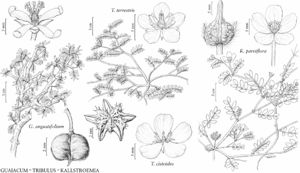Kallstroemia parviflora
Rep. (Annual) Missouri Bot. Gard. 9: 153, plate 46. 1898.
Herbs, annual. Stems prostrate to decumbent or ascending, to 1(–1.5) m, ± coarsely hirsute and sericeous with white or gray antrorse hairs, becoming glabrate. Leaves elliptic in outline, 1–6 × to 3 cm; stipules 5–7 × 1–3 mm; leaflets 6–10(–12), elliptic to oblong, 8–19 × 3.5–9 mm, middle pairs largest, surfaces appressed-hirsute, veins and margins sericeous. Pedicels 10–40 mm in flower and fruit, usually longer than, sometimes equaling, subtending leaves, thickened distally, straight or sharply bent at base and straight distally. Flowers 10–25 mm diam.; sepals persistent, lanceolate, 4–7 × 1–2 mm, 2/3 as long as petals, in flower longer than style, in fruit shriveling and turning brown, appressed to mericarps and reaching from top of fruit body to tip of style, margins becoming sharply involute, hispid and strigose; petals marcescent, 1-colored, orange, drying white to yellow, narrowly obovate, 5–12 × 3.5–5 mm; stamens as long as style; anthers yellow, usually ovoid, rarely linear, less than 1 mm; ovary ovoid, 1 mm diam., hairy; style cylindric, 1 mm, as long or longer than ovary, strigose or glabrous; stigma terminal. Schizocarps ovoid, 3–4 × 4–6 mm, strigose; beak cylindric, 3–9 mm, as long as to 3 times as long as fruit body, base scarcely conic, strigose or glabrous; mericarps 3–4 × 1 mm, abaxially rugose to tuberculate, tubercles if present all rounded, less than 1 mm, sides lightly to strongly pitted, adaxial edge angled.
Phenology: Flowering Jul–Oct.
Habitat: Disturbed areas, grasslands, dry areas.
Elevation: 100–2600 m.
Distribution

Ariz., Calif., Colo., Ill., Kans., La., Mo., Nev., N.Mex., Okla., Tex., Utah, Mexico, introduced in w South America.
Discussion
Kallstroemia parviflora has been reported as a waif in the District of Columbia, Maryland, Mississippi, and Pennsylvania. Once considered a waif in southeastern California, it has been collected there regularly since 2003. The species was introduced into western Peru before September/October 1780 and into southern Ecuador before May 1974 (D. M. Porter 2005).
Selected References
None.
